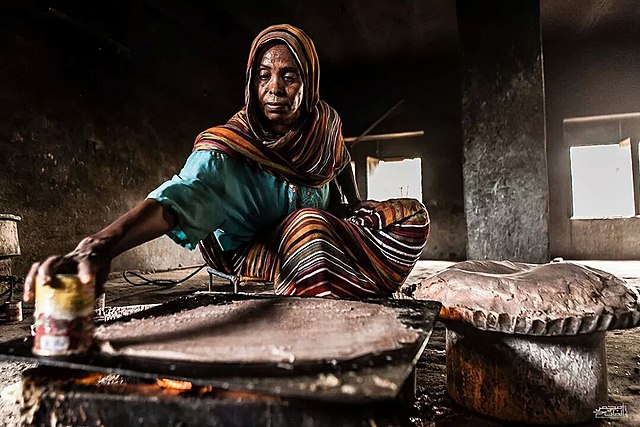Top Qs
Timeline
Chat
Perspective
Kisra
Bread made in Sudan From Wikipedia, the free encyclopedia
Remove ads
Kisra, also spelled kissra (Sudanese Arabic: [ˈkisra] ⓘ), is northern Sudanese popular thin fermented bread[1] made in Sudan, Chad, South Sudan, Algeria and some parts of Uganda and Kenya. It is made from durra or wheat. There are two different forms of kisra: thin baked sheets, known as kisra rhaheefa, which is similar to injera; and a porridge known as kisra aseeda or aceda. The latter is usually paired with a meat and vegetable stew, such as mullah. As of 1995, the then-undivided country of Sudan ate an estimated 20,000 to 30,000 short tons (18,000 to 27,000 t) of sorghum flour annually in kisra.[2]

Remove ads
Sorghum in kisra
Traditionally, in Sudanese households, sorghum is used as a base for making kisra. Sorghum grains are known for having high nutritional value through its minerals and vitamins, which contribute to its anti-inflammatory properties. Two common sorghum varieties are feterita and tabat, which are used to mill fermented flour. This flour is then used in fermented batter that contains a starter from fungal or bacterial fermentation.[3]
Remove ads
See also
Further reading
- Mariod, Abdalbasit (17 February 2023). "Kisra: A Traditional Fermented Flatbread from Sorghum and Millet". Traditional Sudanese Foods: Sources, Preparation, and Nutritional and Therapeutic Aspects. Cambridge Scholars Publishing. ISBN 978-1-5275-9314-5.
- Steinkraus, Keith (4 May 2018). Handbook of Indigenous Fermented Foods, Revised and Expanded. CRC Press. ISBN 978-1-351-44251-0.
- Sulieman, Abdel Moneim Elhadi; Mariod, Abdalbasit Adam (31 January 2022). African Fermented Food Products- New Trends. Springer Nature. ISBN 978-3-030-82902-5.
References
Wikiwand - on
Seamless Wikipedia browsing. On steroids.
Remove ads
